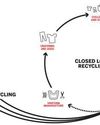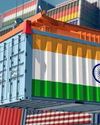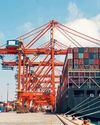Business

Textile Value Chain
Closed-Loop Recycling: From Trash To Treasure
The fashion industry, celebrated for its creativity and perpetual transformation, significantly contributes to global waste and pollution.
4 min |
July 2025

Textile Value Chain
Erbeys Journey to Excellence in Yarn Production with LMW
Established in 2018, Erbey Dokuma İplik Sanayi ve Ticaret A.Ş., headquartered in Sarıçam, Adana, Turkey, quickly rose as a prominent player in the textile industry. With three modern units and a spindle capacity of 71,328, Erbey İplik has consistently expanded its production capabilities, achieving a total yarn production capacity of 62 tons/day for ring yarn and 28 tons/day for open-end yarn.
1 min |
July 2025

Textile Value Chain
India's BRICS Summit 2026 awaits Strategic Opportunities in Global Fashion
India is all set to host the 18th BRICS Summit in 2026, and it is poised to create significant opportunities for the textile, apparel, handloom, and handicraft sectors. The leaders of BRICS nations at their summit in Rio de Janeiro have unanimously extended their full support to India's Chairship, scheduled to be held in 2026. The endorsement came in a joint declaration issued at the conclusion of the 17th BRICS Summit held on 5th July 2025 in Brazil to the Indian Prime Minister Narendra Modi.
2 min |
July 2025

Textile Value Chain
Preferential Patterns: Are FTAs Helping or Hurting India's Textile Industry
The textile industry in India is one of the top 3 employment-generating industries. The apparel industry is ever-growing. With the ongoing US-China trade war, India has perceived this as a blessing in disguise and is preparing itself for the economic boom. With visions like Viksit Bharat, Make in India, and global collaborations taking place every passing day, our textile industry is at the most advantageous place. However, navigating the complexity of a VUCA (Volatile, Uncertain, Complex, and Ambiguous) environment, the fashion and textile sector has seen notable change over the past five years.
2 min |
July 2025

Textile Value Chain
FTA Effects on Indian Textiles: Opportunities and Challenges
What is an FTA? A free trade agreement (FTA) is a pact between two or more countries to eliminate or reduce tariffs, duties, quotas and other trade barriers. The goal is fair, faster, and increased trade, along with cultural and economic cooperation
1 min |
July 2025

Textile Value Chain
Why Innovation-First Climate Tech Is the Future of Fashion Compliance
The constantly evolving landscape of the fashion industry, from evolving silhouettes to fast-paced production cycles, grows on reinvention. However, one fact is becoming more and more obvious as the ecological problem worsens and governmental oversight increases: fashion can no longer afford to innovate solely in terms of aesthetics. The way it sources, creates and assesses its impact must change in the modern era. Climate technology and more especially innovation-first climate technology, is at the centre of this change and will serve as the foundation for fashion compliance in the future.
4 min |
July 2025

Textile Value Chain
Indian Retail Landscape, Game of Thrones: Physical, Digital or Quick!
Retail is the Most Visible Face of the Progress of Consumerism.
5 min |
July 2025

Textile Value Chain
16th Intex Bangladesh 2025: A Landmark Event for South Asia's Textile and Apparel Industry
The 16th edition of Intex Bangladesh, held from 25 to 27 June 2025 at the International Convention City Bashundhara (ICCB) in Dhaka, concluded on a high note, affirming its pivotal role as South Asia's premier international textile sourcing platform. The event showcased the dynamism and evolution of Bangladesh's textile and apparel sector, drawing widespread acclaim from stakeholders across the globe.
3 min |
July 2025

Textile Value Chain
The Eco-Belt: A Metal-Free, Biodegradable Travel Revolution India Must Lead
In 2024, over 4.7 billion people flew globally—each one navigating the same minor but frustrating routine: removing belts at airport security.
3 min |
July 2025

Textile Value Chain
Export Growth...Mission India!!!
Step out of the comfort zone and venture into the growth zone...
9 min |
July 2025

Textile Value Chain
Circularity in Textiles: From Buzzword to Business Advantage
The Circle Is the Future- Linear systems are dying.
2 min |
July 2025

Textile Value Chain
Textile Vs Technology: Created To Please Or Displease?
Corporate Strategies & Communication (CSC)
3 min |
February 2021

Textile Value Chain
STUDY ON PRODUCTION TECHNIQUES USED BY LOCAL TAILORS
STUDY ON PRODUCTION TECHNIQUES USED BY LOCAL TAILORS
7 min |
February 2021

Textile Value Chain
THE EMERGING FUTURE FOR POLYESTER
Polyester (PET) is the most widely used fibre in the apparel industry, accounting for around 52% of the total volume of fibres produced globally. The apparel industry accounts for around 32 million tons of the 57 million tons of polyester used each year [1]. It is used widely in technical textiles as well.
6 min |
February 2021

Textile Value Chain
WEBINAR ON TECHNICAL TEXTILE
Our honorable Ms. Smriti Zubin Irani Ji, Minister of Textiles, Information and Broadcasting and Women and Child Development, India from BJP representing Amethi constituency has took many steps to uplift the Textile Industry and has been seen in Conference held for technical textile this year.
4 min |
February 2021

Textile Value Chain
POLYESTER VALUE CHAIN
The origin has many names and named by the companies producing it. It started with the discovery of Nylon in United States then Terylene in England.
2 min |
February 2021

Textile Value Chain
PET a necessary evil
How often do we see PET around us? If you observe we are surrounded with PET and its variants. From apparels to heavy industrial textiles, PET has become one of the most important fiber to humans. This is because of its amazing properties. It is strong, stable, and durable, If we compare it with natural fibers, it is cheaper with such features.
3 min |
February 2021

Textile Value Chain
LOCKDOWN IN UK AND EUROPE HAS DRASTICALLY CHANGED THE MARKET OF IMPORT AND EXPORT
LOCKDOWN IN UK AND EUROPE HAS DRASTICALLY CHANGED THE MARKET OF IMPORT AND EXPORT
1 min |
February 2021

Textile Value Chain
IKEA IN INDIA – CASE STUDY
It has made its presence in India and has planned growing its root here and opened recently in Navi Mumbai in December 2020.
4 min |
February 2021

Textile Value Chain
KHITISH PANDYA: FOUNDER, ECO TASAR
Khitish Pandya has been involved with tasar silk textiles since 2000. He was brought in by PRADAN- an NGO to help build the business side of the silk yarn making project initiated by PRADAN.
1 min |
February 2021

Textile Value Chain
AUTOMATION IN APPAREL INDUSTRY
Automation is most often defined as, automatically controlled operation of an apparatus, process or system by mechanical or electronic devices that take the place of human organs of observation, effort, and decision. The purpose of this paper was to investigate the status and the effects of technology adoption on the level of organizational factors within the context of the apparel industry.
10+ min |
February 2021

Textile Value Chain
Sustainable Is The Way To Be
Textile Value Chain gets in conversation with Mr. Anjani Prasad, MD, Archroma India, Nepal and Sri Lanka; a company which is taking extraordinary steps and walking the walk of sustainability in its true meaning. Even though there is a long way to go, small steps and initiatives taken by Archroma could help the industry push the sustainability goals.
6 min |
January 2021

Textile Value Chain
Interiors Defined : Home Textiles & Categories
Textiles are a millennia old, and maybe close to as old as the dawn of human race. This makes materials one of our most established works of art, and one sort of home textiles may rank among the main types of this workmanship. Textiles have for some time been utilized as floor covers, making a feeling of separation between the inside of a home and the earth. Indeed, even in traveling, floor covers are regularly seen as a need. In numerous societies, floor covers work as wall coverings as well.
7 min |
January 2021

Textile Value Chain
VOLKSWAGEN INDIA DRESS RE-DESIGN COMPETITION IN COLLABORATION WITH NIFT
Volkswagen launched a dress redesign competition which was conducted for students of 2020 Fashion Design Batch of NIFT Institute across the country. The initiative provided a collaborative platform for young talents to showcase and implement their desig nskill in creating a refreshed and visually appealing dress code for VW sales professionals.
3 min |
January 2021

Textile Value Chain
THE SHAPE OF HOME TEXTILES
Year 2021 will be all about taking a closer look at what you choose for your home, elements that represent you, make your soul feel at home are the most calming choices. While choosing for textures and colors, visualize the element if your favorite nook and a couple more spaces before you buy.
2 min |
January 2021

Textile Value Chain
SUSTAINABLE FIBRES FOR HOME FURNISHINGS
The textile industry has been an ongoing evolutionary industry since the dawn of Human civilization.
4 min |
January 2021

Textile Value Chain
NEVER STOP
Driven with passion, the AIO group strongly believes in its tagline, which is NEVER STOP. The founder, Harshit finds inspiration in his brand which has been built considering some risks all the while following the passions. Started with just an idea and vision, AIO group today stands strong in the market for sportswear. The brand and its founder believe that to achieve heights, the first thing one needs to do is start. Working diligently and consistently follows.
4 min |
January 2021

Textile Value Chain
IMPROVING YOUR COMPANY'S PERFORMANCE: 3 TIPS TO SETTING UP AN EFFECTIVE PERFORMANCE MANAGEMENT SYSTEM WHICH GIVES RESULTS
An organization which does not measure and monitor the performance of every employee cannot reach optimum level of performance. Human beings naturally love challenges and most of us need a target or a goal to aspire for. At the workplace too, in case we do not have a clear goal; most employees prefer to meander along doing what is minimum requirement to get their monthly salary. It is therefore imperative that all organizations have some method of measuring and monitoring performance.
2 min |
January 2021

Textile Value Chain
FUTURE OF SUSTAINABLE FASHION IN INDIA- KAMAKHYAA
YOUR ONE-STOP ONLINE SHOPPING DESTINATION FOR SUSTAINABLE AND LUXURY WOMEN’S WEAR FASHION.
4 min |
January 2021

Textile Value Chain
A.T.E. PARTNERS WITH W+D BICMA, GERMANY, TO BRING TEXTILE HYGIENE MANUFACTURING TECHNOLOGIES TO INDIA
The ongoing pandemic has brought renewed focus on the medical and hygiene segment in textiles.
1 min |
